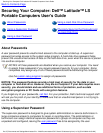
Back to Contents Page
PC Cards: Dell™ Latitude™ LS Portable Computers
User's Guide
About PC Cards Removing PC Cards
Installing PC Cards Configuring PC Cards
About PC Cards
On the right side of the computer is a PC Card slot in which you can install PC Cards that
comply with Release 2.01 of the Personal Computer Memory Card International Association
(PCMCIA) standard and Release 4.2 of the Japanese Electronic Industry Development
Association (JEIDA) standard.
The computer supports type I and type II PC Cards, such as modems, local area network (LAN)
cards, wireless LAN cards, and small computer system interface (SCSI) cards. Also supported
are such memory devices as static random-access memory (SRAM) cards that emulate
diskettes, random-access memory (RAM) cards, and one-time programmable (OTP) ROM
cards, and advanced technology attachment (ATA) cards that emulate integrated drive
electronics (IDE) hard-disk drives.
If you are using the Microsoft® Windows® 95 or Windows 98 operating system, you can use a
zoomed video (ZV) PC Card, such as a hardware Moving Picture Experts Group (MPEG)
decoder. (The Microsoft Windows NT® 4.0 operating system does not support ZV.)
NOTES: A PC Card is not a boot device.
The "type" of a card refers to its thickness, not its functionality.
Your computer recognizes most input/output (I/O) cards and automatically loads the
device driver associated with that card.
NOTICE: Take extra precautions if you use extended PC Cards in your computer.
Extended cards are longer versions of standard PC Cards. They fit into, and operate
correctly with, your computer. However, they extend beyond the edge of the computer
when installed. If something strikes the exposed end of an installed card, your system
board can be damaged. Always remove an extended PC Card before you pack the
computer in its carrying case.
PC Cards: Dell Latitude LS Portable Computers User's Guide
file:///C|/Documents and Settings/Administrator/De...w Web/Documentation/LS/LS User's Guide/pccards.htm (1 of 4) [5/31/2000 9:46:25 AM]


















